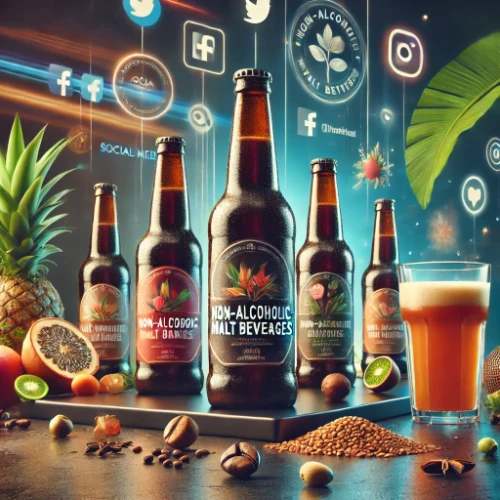Non-alcoholic malt brewing is a fascinating process that captures the deep, satisfying flavor of malt without any alcohol. This carefully controlled method combines traditional brewing techniques with modern innovations, producing a refreshing and wholesome drink. Let’s take a step-by-step look at how non-alcoholic malt beverages are made and what makes them so unique.
Step 1: High-Quality Ingredients
The process begins with carefully chosen ingredients. Brewers use top-quality barley or other grains, hops, water, and a controlled amount of brewing sugar. Each ingredient directly impacts the drink’s flavor and texture. Often, natural fruit extracts, spices, or caramel are added for extra flavor, giving each brand its distinctive twist.
Step 2: Malting the Barley
Malting is key to creating a rich, malty flavor. Brewers soak barley in water, allow it to germinate, and then dry it in a kiln. This step converts the barley’s starches into fermentable sugars, which are essential for brewing. Roasting the malt to various degrees brings out flavors ranging from light and sweet to dark and caramel-like.
Step 3: Mashing and Boiling
Next, the malted barley is mixed with hot water in a step called mashing. This activates enzymes that further break down the malt’s starches into sugars. The resulting liquid, known as wort, is then separated from the solid grains. Brewers boil the wort, sometimes adding hops for extra flavor. Boiling also sterilizes the wort, ensuring a clean, high-quality product.
Step 4: Controlled Fermentation
At this stage, most brewing processes would add yeast to convert sugars into alcohol. However, in non-alcoholic malt brewing, the fermentation process is carefully managed to prevent alcohol formation or keep it extremely low (under 0.5% ABV). Brewers may use specialized yeast that produces minimal alcohol or halt the process early to retain the malt character without the alcohol content.
Step 5: Filtration and Carbonation
Once fermentation is complete, the drink is filtered to remove any remaining particles, creating a smooth, clear beverage. Some brands pasteurize the drink to ensure stability and freshness. Next, carbonation is added, providing the refreshing effervescence that enhances the drink’s flavor and mouthfeel.
Step 6: Flavor Enhancements and Bottling
To give each brand its unique taste, flavors like fruit infusions or hints of caramel are often added at this stage. Once the flavor is perfected, the drink is bottled or canned in sterilized containers, ensuring that it’s fresh and ready to enjoy.
The Art of Non-Alcoholic Malt Brewing
What sets non-alcoholic malt beverages apart is the way they deliver the rich, layered taste of malt while remaining alcohol-free. The brewing process preserves the natural flavors—whether sweet, roasted, or slightly bitter—without the kick of alcohol. This results in a flavorful, enjoyable beverage that’s both refreshing and wholesome.
A Healthy and Flavorful Choice
Non-alcoholic malt drinks offer not only a great taste but also nutritional benefits. Packed with vitamins, minerals, and often lower in calories than sugary sodas, they provide a guilt-free way to quench your thirst. Whether you’re looking to reduce alcohol intake, enjoy a midday pick-me-up, or simply love the taste of malt, these beverages offer a perfect balance of flavor and wellness.
So next time you savor a bottle of non-alcoholic malt, remember the intricate process that brings its taste to life. From roasted malt to a touch of sweetness, each sip is a blend of tradition and innovation, delivering all the satisfaction of malt in an alcohol-free format.
To expand information on this post go to brewersassociation.org
Related Links for Malt Fans
- The Chemistry Behind Non-Alcoholic Malt Flavor
Learn how brewing science influences the flavors of malt beverages. - Caramel Sugar Enhances Malt Drinks
Understand the role of caramel sugar in enhancing malt drink profiles. - Brewing Malt Beer: Tradition Meets Innovation
Discover how brewing traditions are evolving with modern techniques.





Do you have equipment for production of these non alcoholic malt drinks from maize and sorghum or can you recommend any reliable supplier?
Got so much desire and interest in this value addition of these two cereals.
Thank you for your message and interest in non-alcoholic malt drink production.
At DrinkMalt.com, we focus on promoting finished malt beverage products and for now, we do not supply equipment. However, you may want to explore equipment manufacturers specialized in beverage processing such as GEA, Krones, Buhler, or TechniBlend, which offer systems adaptable to ingredients like maize and sorghum.
We wish you the best in your venture and hope your project finds great success!
Faço cerveja artesanal para consumo caseiro.
Gostava de ter uma receita desta bebida maltada para fazer em casa e dar a provar aos meus amigos.
Olá Carlos! Muito obrigado pela sua mensagem e pelo interesse nas bebidas maltadas sem álcool. 👨🔬🍺
Ficamos felizes em saber que faz cerveja artesanal para consumo caseiro — temos certeza de que seus amigos vão adorar experimentar uma boa malta feita por você!
Aqui está uma receita caseira básica para preparar uma bebida de malte sem álcool (ou com teor muito baixo, até 1%). A receita é a mesma que você comentou, com pequenas adaptações para facilitar o processo para cervejeiros caseiros:
Ingredientes para 20 litros de bebida:
4,5 kg de malte escuro (moído de forma grossa)
100 g de lúpulo (disponível em farmácias especializadas ou lojas de insumos cervejeiros)
Levedura de alta fermentação (tipo ale)
400 g de glicose (opcional, para sabor e corpo)
2 panelas grandes (ideal com controle de temperatura)
2 fraldas de pano (para filtragem)
Termômetro
Mangueira para envase
40 garrafas com tampa flip-top
Vasilhame para fermentação (mínimo 30 litros)
Processo resumido:
Ative a levedura 12 horas antes com água morna e um pouco de suco ou açúcar.
Faça o mosto com três etapas de temperatura:
15 min a 50°C
20 min a 65°C
30 min a 72°C
Filtre o mosto com a fralda adaptada e adicione 16 litros de água a 80°C para lavar o bagaço.
Ferva por 1 hora com o lúpulo.
Filtre novamente e resfrie até 20°C.
Adicione a levedura e deixe fermentar de 10 a 20°C por 24 a 48 horas.
Pasteurize: aqueça as garrafas fechadas em banho-maria a 65°C por 30 minutos para evitar fermentação posterior.
Resultado: Uma bebida de malte deliciosa, doce, nutritiva e com gás natural – perfeita para compartilhar com os amigos! 🥂
Caso experimente, adoraríamos ver o resultado! Se quiser, podemos também te enviar uma ficha técnica PDF com instruções detalhadas.
Grande abraço de toda a equipa DrinkMalt.com!